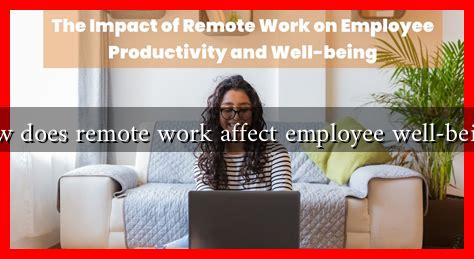-
Table of Contents
How Does Remote Work Affect Employee Well-Being?
The shift to remote work has transformed the landscape of employment, especially in the wake of the COVID-19 pandemic. While many employees have embraced the flexibility and autonomy that remote work offers, it has also raised questions about its impact on employee well-being. This article explores the multifaceted effects of remote work on mental, physical, and social well-being, providing insights backed by research and real-world examples.
The Positive Aspects of Remote Work
Remote work has several advantages that can enhance employee well-being. Here are some of the key benefits:
- Flexibility: Employees can often set their own schedules, allowing for a better work-life balance. This flexibility can lead to reduced stress and increased job satisfaction.
- Reduced Commute: Eliminating the daily commute saves time and money, contributing to lower stress levels and more time for personal activities.
- Increased Autonomy: Remote work often empowers employees to take ownership of their tasks, leading to higher motivation and engagement.
- Personalized Work Environment: Employees can create a workspace that suits their preferences, which can enhance comfort and productivity.
According to a study by Buffer, 32% of remote workers cite flexibility as the biggest benefit of working from home, highlighting its importance in promoting well-being.
The Challenges of Remote Work
Despite its advantages, remote work also presents challenges that can negatively impact employee well-being:
- Isolation: Remote workers may experience feelings of loneliness and disconnection from colleagues, which can lead to mental health issues.
- Work-Life Boundaries: The blurring of lines between work and personal life can lead to burnout, as employees may find it difficult to “switch off.”
- Communication Barriers: Remote work can hinder effective communication, leading to misunderstandings and decreased collaboration.
- Access to Resources: Not all employees have access to a conducive work environment or the necessary tools, which can affect productivity and morale.
A survey conducted by the American Psychological Association found that 61% of remote workers reported feeling more stressed than they did before the pandemic, underscoring the potential downsides of this work model.
Strategies for Enhancing Well-Being in Remote Work
Organizations can implement several strategies to mitigate the challenges of remote work and promote employee well-being:
- Regular Check-Ins: Managers should schedule regular one-on-one meetings to discuss workload, challenges, and personal well-being.
- Encourage Social Interaction: Virtual team-building activities and informal catch-ups can help combat feelings of isolation.
- Set Clear Boundaries: Encourage employees to establish specific work hours and take regular breaks to maintain a healthy work-life balance.
- Provide Resources: Offer access to mental health resources, such as counseling services or wellness programs, to support employees’ mental health.
For instance, companies like GitLab have implemented a “remote-first” culture that emphasizes communication and well-being, resulting in high employee satisfaction and retention rates.
Conclusion
Remote work has a profound impact on employee well-being, offering both significant benefits and notable challenges. While the flexibility and autonomy of remote work can enhance job satisfaction and reduce stress, issues such as isolation and blurred work-life boundaries can lead to negative outcomes. By proactively addressing these challenges through effective communication, social interaction, and support resources, organizations can foster a healthier remote work environment. As the future of work continues to evolve, prioritizing employee well-being will be crucial for sustaining productivity and engagement in a remote setting.
For further reading on the impact of remote work on employee well-being, you can explore resources from the American Psychological Association.


